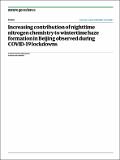Por favor, use este identificador para citar o enlazar a este item:
http://hdl.handle.net/10261/344319COMPARTIR / EXPORTAR:
 SHARE SHARE
 CORE
BASE CORE
BASE
|
|
| Visualizar otros formatos: MARC | Dublin Core | RDF | ORE | MODS | METS | DIDL | DATACITE | |

| Título: | Increasing contribution of nighttime nitrogen chemistry to wintertime haze formation in Beijing observed during COVID-19 lockdowns |
Autor: | Yan, Chao; Tham, Yee Jun; Nie, Wei; Xia, Men; Wang, Haichao; Guo, Yishuo; Ma, Wei; Zhan, Junlei; Hua, Chenjie; Li, Yuanyuan; Deng, Chenjuan; Li, Yiran; Zheng, Feixue; Chen, Xin; Li, Qinyi CSIC ORCID; Zhang, Gen; Mahajan, Anoop S.; Cuevas, Carlos A. CSIC ORCID; Huang, Dan Dan; Wang, Zhe; Sun, Yele; Saiz-Lopez, A. CSIC ORCID; Bianchi, Federico; Kerminen, Veli Matti; Worsnop, Douglas R.; Donahue, Neil M.; Jiang, Jingkun; Liu, Yongchun; Ding, Aijun; Kulmala, Markku | Fecha de publicación: | 1-nov-2023 | Editor: | Nature Publishing Group | Citación: | Nature Geoscience 16: 975–981 (2023) | Resumen: | Nitrate comprises the largest fraction of fine particulate matter in China during severe haze. Consequently, strict control of nitrogen oxides (NOx) emissions has been regarded as an effective measure to combat air pollution. However, this notion is challenged by the persistent severe haze pollution observed during the COVID-19 lockdown when NOx levels substantially declined. Here we present direct field evidence that diminished nitrogen monoxide (NO) during the lockdown activated nocturnal nitrogen chemistry, driving severe haze formation. First, dinitrogen pentoxide (N2O5) heterogeneous reactions dominate particulate nitrate (pNO3−) formation during severe pollution, explaining the higher-than-normal pNO3− fraction in fine particulate matter despite the substantial NOx reduction. Second, N2O5 heterogeneous reactions provide a large source of chlorine radicals on the following day, contributing drastically to the oxidation of volatile organic compounds, and thus the formation of oxygenated organic molecules and secondary organic aerosol. Our findings highlight the increasing importance of such nocturnal nitrogen chemistry in haze formation caused by NOx reduction, motivating refinements to future air pollution control strategies. | Versión del editor: | https://doi.org/10.1038/s41561-023-01285-1 | URI: | http://hdl.handle.net/10261/344319 | DOI: | 10.1038/s41561-023-01285-1 | ISSN: | 1752-0894 |
| Aparece en las colecciones: | (IQF) Artículos |
Ficheros en este ítem:
| Fichero | Descripción | Tamaño | Formato | |
|---|---|---|---|---|
| SUPPLEMENTARY INFORMATION.pdf | Supplementary information | 801,15 kB | Adobe PDF |  Visualizar/Abrir |
| REVISE~1.DOC | 3,49 MB | Microsoft Word | Visualizar/Abrir |
CORE Recommender
SCOPUSTM
Citations
5
checked on 28-abr-2024
Page view(s)
18
checked on 01-may-2024
Google ScholarTM
Check
Altmetric
Altmetric
NOTA: Los ítems de Digital.CSIC están protegidos por copyright, con todos los derechos reservados, a menos que se indique lo contrario.
